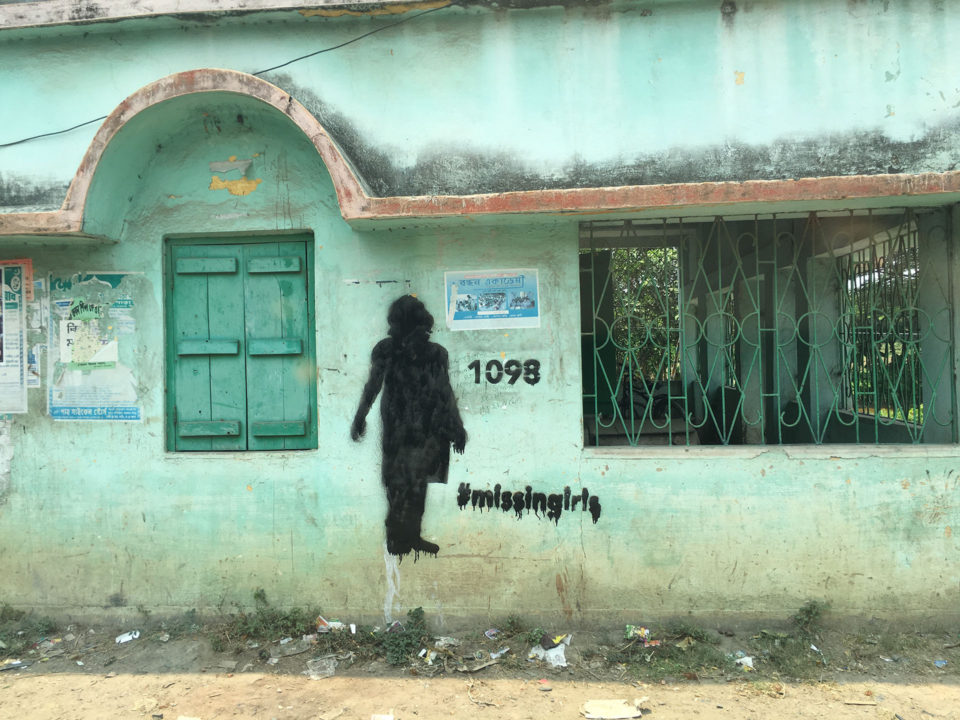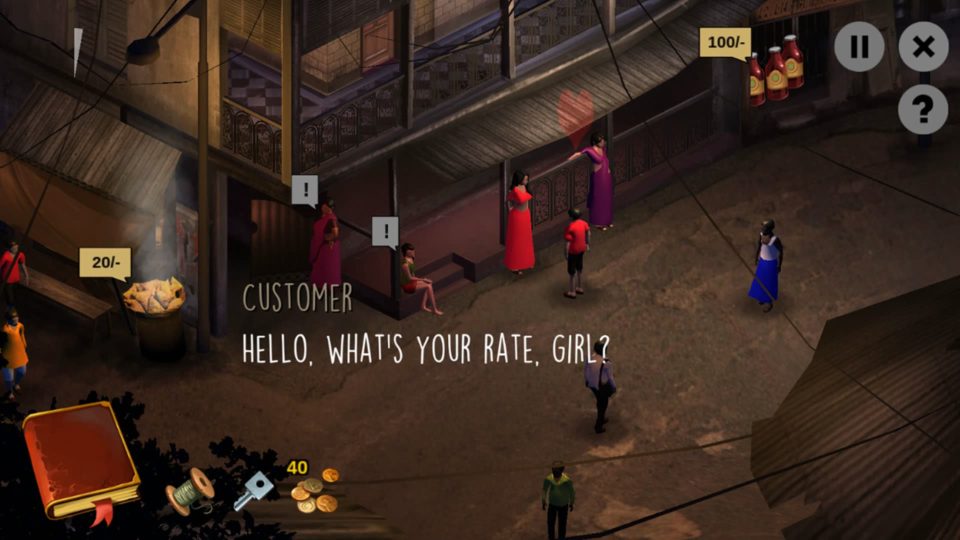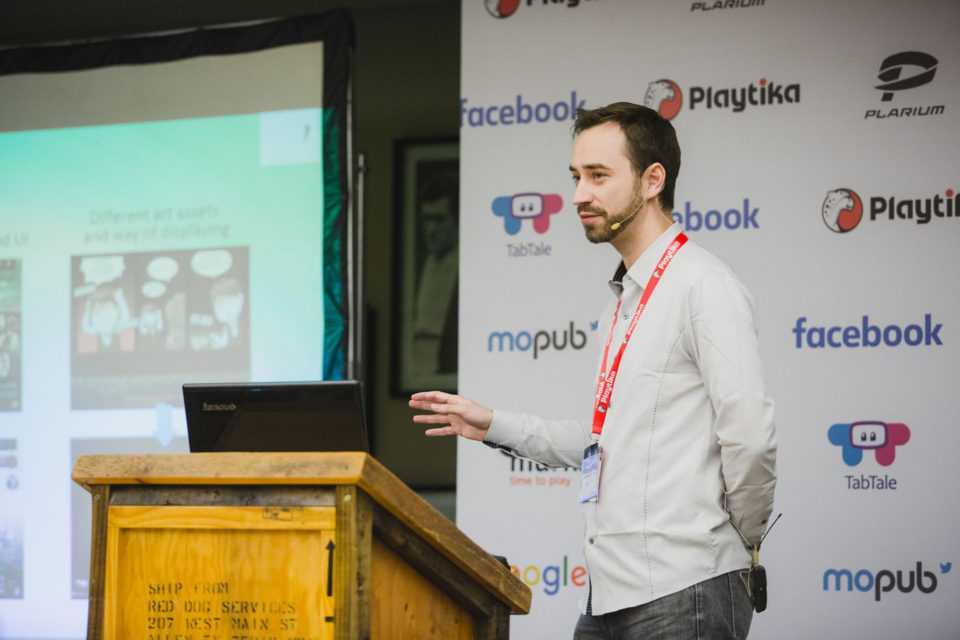As one of the biggest mobile publishers in the world, Playrix has a lot of insight on how to resonate on a global scale. Tune in to an interview at Casual Connect Europe between Catherine Mylinh, VP of Marketing at Vungle, ad Artur Grigorjan, Marketing Growth Director at Playrix, in a discussion on how to grow a loyal player base and how to scale this approach to drive engagement and monetization. One of many tips Artur shared was: “More money will be pumped into user acquisition so as a smaller developer try to look out for optimizing your game for smaller volumes. Do not compete with higher budgets. Focus on your game first, UA (user acquisition) second.” See the full session below.
main
Asia 2017Video Coverage
Simon Toh: The Keys to Approaching the APAC Region | Casual Connect Video
The time for Asian-Pacific mobile app publishers to switch to programmatic methods for monetizing. As the Head of APAC Platform Sales for MoPub, Simon Toh spoke about the need for developers to take advantage of mobile programmatic to monetize risk so that they don’t miss out on differentiated demand, revenue and control user experience. Simon stated, “To grow your top line, it is important for you to find new ways to monetize more of your users preferably all of them and not be overly dependent on in-app purchases.” During his talk at Casual Connect Asia, Simon also delved into what the beneits for publishers which included a glimpse into innovative ad formats and spend trends in the APAC market. To learn more, tune in to the video below of his full session.
BusinessExclusive Interviews
From Gamedev to Insurance Business: How To Use The Skills
Is there life after gamedev? While numerous people ask about how to get into the games business, some use it as a kickstart for their careers, eventually ending up in other industries. Like, for instance, Robin Kiera, formerly an in-house consultant for Goodgame studios, Casual Connect speaker, and then project lead at an insurance company.
Robin is now experiencing and documenting how gaming industry experts can help traditional industries to introduce fast, sophisticated, customer-centric products, services, and business models. “Or they can join startups and challenge traditional players”, he says.
Europe 2017Video Coverage
Yuli Zhao: Calling on Angels to Bridge the East/West Gap | Casual Connect Video
It can be really tough to break into the Asian market, maybe even mysterious. Although there is a large difference in user behavior between Western and Asian players, Youzu Interactive has been very successful in localizing games. They have even been able to make it into the Top 10 in more than 60 countries overseas. In a lecture at Casual Connect Europe entitled Going Global – Local Operation Experience for Over 100 Countries, Yuli Zhao focused on what developers should do rather than what they shouldn’t do. Here is a key finding that Yuli described: “Because there are a small group of deep pocket players, whale players, in Asian games, when we bring the game to Western markets we don’t want to make the non-paying users feel bad about it so there are some items which is to price extremely high in our previous version in Asian market. Actually, we divided these items into smaller packages so that when the players pay for the virtual items, they will view the pricing as not that high but in reality, they need to buy the whole group of virtual items to get the final ones.”
Three of the top world markets comes from Asia are China, North America and Japan. Here are three findings which Yuli highlighted:
- Style is not fine Art: Glowing effect and outstanding outfit affected why they got features by Apple.
- Compatibility: Fast frame speed on lower end mobile phone at 20+ a must.
- Localization: extend the life cycle of the game by changing rewards, difficulty by country and the number of incoming game events.
For more useful tips on how to break through the cross-cultural barrier, see the full lecture below.
DevelopmentExclusive InterviewsIndie
Missing Finds the Right Tone to Address Human Trafficking

“Each and every project is led by me, AKA Flying Robot,” said Satyajit. “I choose my team members and assign tasks to them.”
“I started Missing as a public art project and campaign, thought I collaborating with various people like psychologists, sociologists, campaign creators, governments, NGOs to taking the project forward,” noted Leena.
Since releasing, Missing won the Indie Game of the Year at NASSCOM Gaming Forum Awards 2016. NASSCOM is an organization that represents and sets the tone for public policy for the Indian software industry. “NASSCOM Indie Game of The Year Award is the most coveted award for indie game developers in India,” said Satyajit. “This award is specifically meant to recognize, promote and accelerate indie studios in India. And for my small indie studio, Flying Robot Studios, it gave the much needed enthusiasm and exposure which is vital for our future as game developers.”
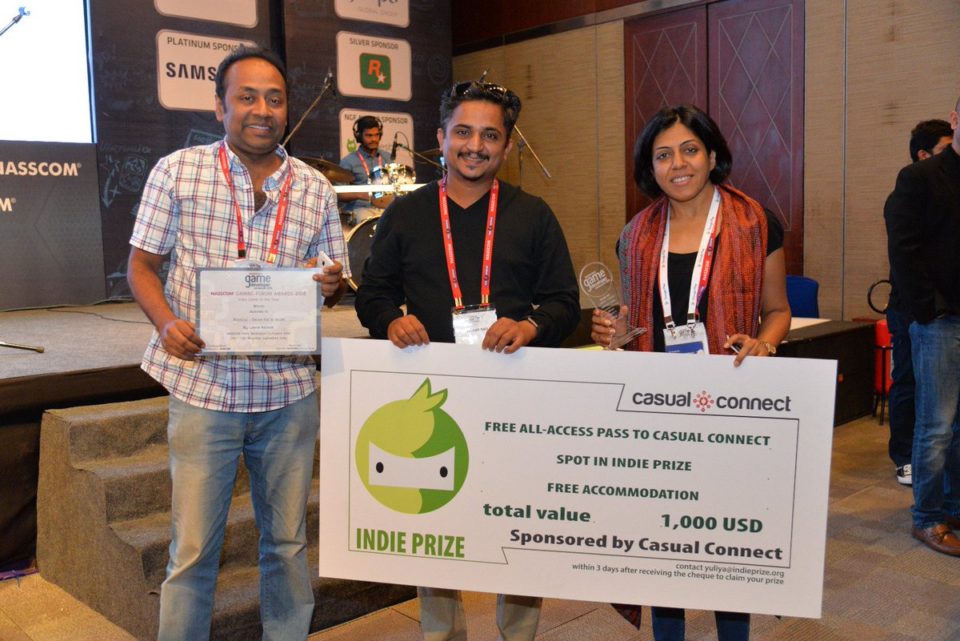
“This award was highly significant,” noted Leena. “It was truly a great surprise because initially when I thought of a game app for a cause, my intention was to create a game playable enough to go through schools and NGOs for raising awareness on the issue of sexual trafficking. Though me and Satyajit did have sleepless nights on how we could make the gameplay interesting enough for the players, but he did manage to put together a gameplay which was interesting enough. But to receive the Indie Game of the Year award, was truly momentous, and it helps me take the awareness of the issue to a wider gaming audience in India and abroad.”
As a further honor, Missing will be shown off at Indie Prize as part of Casual Connect Europe 2017 in Berlin, which will open the game up to a variety of people who may otherwise not know about it. “Me and my studio is fairly a new kid on the block,” said Satyajit. “The game Missing which I designed reflects my orientation as a game designer and I’m keen on a qualitative analysis of the design style, to find it’s merits and flaws. So, the best way to find out is to show it to a wider audience. And Indie Prize Berlin 2017 is the perfect opportunity to get all the eminent game designers, developers and players (especially European) in one place. I’m looking forward to using this platform to interact with them about the game and my future projects. This is the best thing that can happen for a budding game designer. Thank you Indie Prize for this opportunity!”
“It gives me access to the European audience to talk about the issue of sexual trafficking through the game because as we know trafficking is not just in India, it’s a global issue, and all should address it,” said Leena. “It also give me the possibility of making a localized European version of the game.”
Bringing Dark Parts of Society to Light
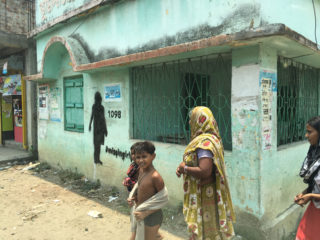
Missing was originally conceived as a way to draw more attention to the ongoing problem of human trafficking. It was Leena’s idea originally, with Satyajit being brought on later to develop the game and the YES Foundation assisting in the production.
“The Missing game is a part of the larger awareness campaign and Missing Public Art Project, which I’d launched a year back,” said Leena. “The art work has been a culmination of my decade long work as an artist on the issue of sexual trafficking. A year back I specifically created public art works as I wanted to move out of the galleries, and speak to a wider audience. As a photographer in my explorations of the city I explored areas and spaces, which you normally don’t go to, and my first visit to a red light lane left a lasting impact. I saw that which remained unseen. The whole comprehensive work can be seen at SaveMissingGirls.com and the game is part of a whole four-part project, and a ground level stencil campaign featuring the silhouette.”
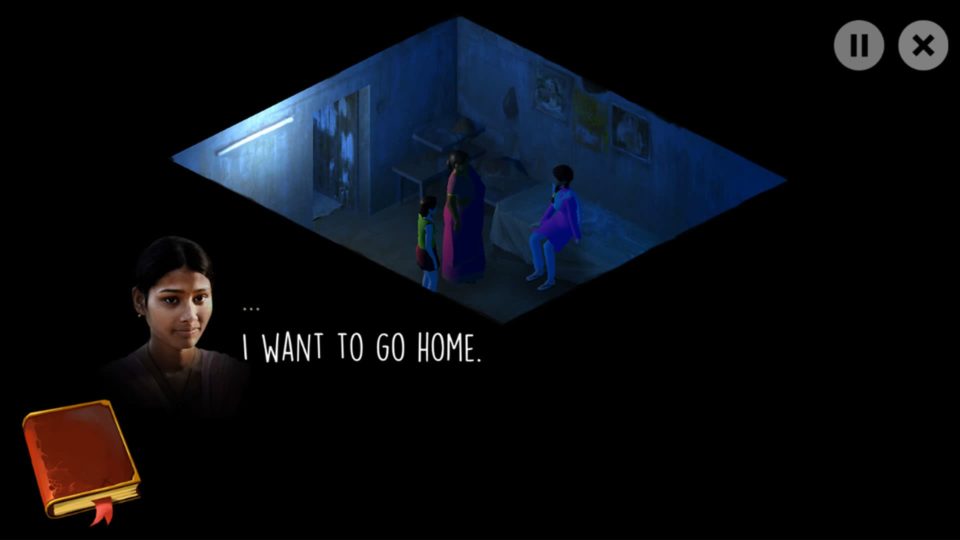
“The YES Foundation has generously come forward and supported the initial production of the game,” Leena added. “This gives us more room space to convert the game into a PC version and to take it to the next step.”
While Missing is a game with an obvious message, Satyajit said it was key to accomplish this without preaching. “The game poses a challenge to the player, which the player has to overcome throughout the game to win it,” said Satyajit. “The plot, challenges and the narrative was based off journalistic research. That way the game provides a fair amount of tangential learning about the cause of women trafficking not only in Kolkata, but throughout India.

“The main purpose of creating a game for a change like Missing was to make the player slip into the shoes of the trafficked victim,” noted Leena. “Feel her frustration and angst and vulnerability, and her absolutely hopelessness in the situation which she is, so that they would become sensitive to the issue of girls whom they see ‘selling’ sex. Because the layman never really understands her background and most often think she is standing there voluntarily. With this we hope to end demand, this is in sync with the cry of end demand throughout our campaign, because trafficking is a demand-driven market.”
“Video games are the perfect (way) to engage the audience in the deepest way possible and adventure games with strong narratives based on journalistic researches can strike a chord with the audience,” noted Satyajit. “What’s told in Missing is a human tale, with believable characters. Not taking refuge to fantasy, which can be easier for a game designer. Also game designers are particularly worried about players rage quitting if the game is not fun enough - I’d suggest them to shed this fear. Being truthful to the cause and the reality is the key. As truth is stranger than fiction, it’s also stronger than fiction and proper use of it in games will imprint itself into the player’s mind that can last forever.”
About More than Mechanics
Missing was tested on many types of players. This included hardcore gamers and those who don’t play many games at all. Satyajit said that the reactions to the game were quite varied.
“I’ve designed Missing targeted at a casual audience, not expert players. What I found is experienced players play games with a specific perception of the reality which can actually be a hindrance in experiencing the game,” noted Satyajit. “I’ll give you a specific example, in the chapter 1 of the game Missing, the player character is captive and the first choice the player has to make is to accept/reject food from her captors. Experienced players immediately accept the food, taking it as some kind of health point or loot. Whereas inexperienced casual players relates this to a real life choice and will mostly reject the offer. This gave me a unique insight to the audience mentality, especially in India and a way to connect with them.”
“As this game is narrative based, it can only be tested after it hits beta. To test out the complete story arc. I really can’t test early alphas or little mechanics with this type of games. Those testing we (did) internally. External testing was done by simply inviting players for game sessions and watching them play behind their shoulder, taking notes,” noted Satyajit. “Playtesting is very critical to all my projects. I depend upon it a lot to make design changes, especially where there are gameplay elements. A game’s success depends on it in a big way.”
Satyajit noted that some games require almost daily testing, others are done weekly. Satyajit prefers to use new players every time, using online forums to recruit them. “I usually open up a beta testing group in Google groups or Facebook groups depending upon the particular player migration,” said Satyajit. “I track the user feedback through analytics platform like Google Analytics and more descriptive feedback through Google forms that the user can fill after playing the game. I generally have more than one beta groups for testing a game.”
Collective Effort for a Cause

“Flying Robot Studios is a one man army apart from the support staff. I expand upon project requirements and almost always recruit project based staff based on their talents, not locations,” said Satyajit. “I take care on choosing the right people, specifically those who will not compromise with their work quality to attend a deadline or closing a freelance gig. Who will rather miss a deadline and quarrel with the client than delivering a mediocre product. Game development is not a factory job, sometimes the creative magic doesn’t happens in a team member. I completely understand that and support them until they are satisfied with their work. So far, this work culture has worked for me.”
“Every game project is designed by me and I always choose a flexible and modular development framework and keep it flexible almost to the end of the project,” Satyajit continued. “After the initial design is done, I prototype it using assets made by me or from stock assets. Then the game gets into playtesting and design iterations until I arrive at a point where the design is working and the polishing can begin. At this stage I get to recruit asset artists and animators depending upon workload and deadline. Also, I recruit writers to polish the narrative and later music composers for the soundtrack and sound effects. Entire coding and bug fixing is done by me alone.”
For Missing, Leena delivered the original concept for the game. From there, it was all about working with Flying Robot Studios in delivering the product. “The main aim in the whole process is to put out the silhouette in front of various audiences, be it gamers, the city public, the international community, the online community, and all this is covered by the stencil project, the game and the installation,” detailed Leena. “The image is like a constant reminder, and a remembrance of the millions of girls who disappear from the face of the earth into the dark hole of sexual trafficking.”
Promotion for the Missing game was a collaboration between like-minded people. Leena says that those who demand the end of human trafficking have been important in helping to make Missing happen.
“Since the project started many people from across the world have come in to be a part of the campaign either via social media, or the crowdfunding, the global stencil project – in a similar fashion, when we first began discussing the app, there was much brainstorming about what the app could do before we zeroed in on a game for a cause,” said Leena. “And this led to the collaboration and Satyajit, as he is a game designer. The Missing team worked with him to expose him on the dark issues of trafficking. I took him to meet survivors in rural Bengal that the Missing project has helped save and rehabilitate, we took him into red light districts of the city to experience the atmosphere and mood of these spaces. An in depth discussion with a survivor also led him to understand the intimate details of the business interaction between client and victim. I also gave him the script of a film tackling the issue, which really helped him the scripting of the game itself.”
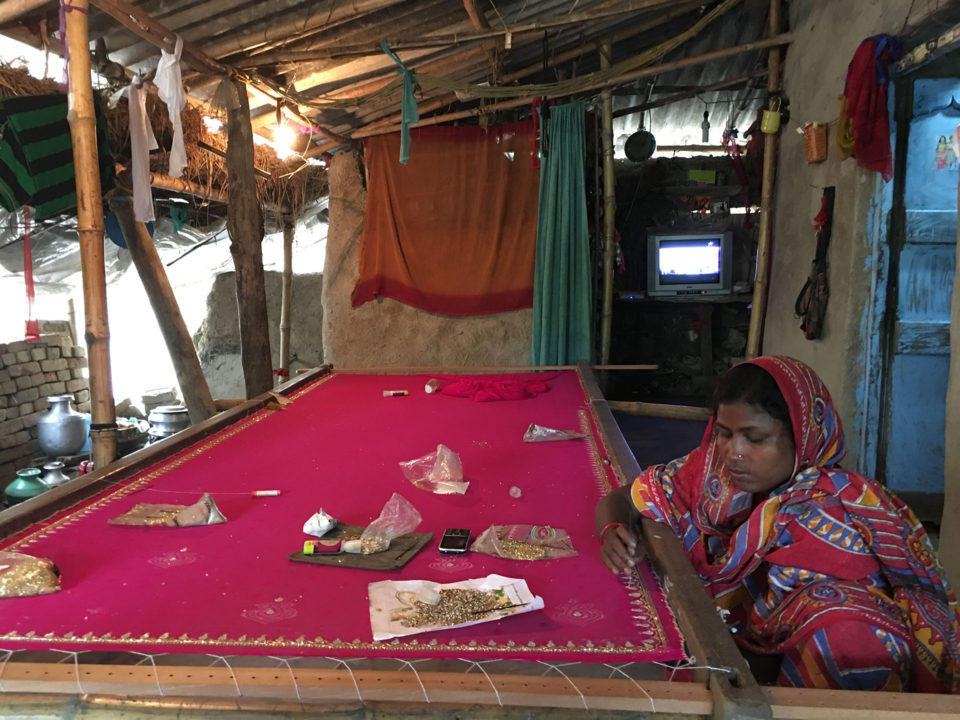
“Though Missing is based in Kolkata our campaign has been truly global and hence mainly virtual,” Leena added. “We give equal attention to our online campaign on anti-trafficking as much to the grass roots level work. Most of our interactions to further project happens online via the DIY kit, the game, the social media campaign truly makes it virtual.”
The Missing team is seeking crowd funding through Indiegogo for the extended and PC version of the game. They aim to convert it to 13 vernacular Indian languages and localize the game for around six international languages. “We would like the gamers support to help us do that and help save more girls and futures in India,” explained Leena.
Silhouette As a Sublime Distillation
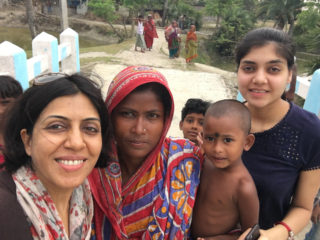
Flying Robot Studios has used a variety of monetization schemes for it’s various games, with PC games being premium and mobile games being free with ads and/or in-app purchases. Missing, however, has been different because of the way it was made and its intended audience.
“Missing Game for a Cause has been crowd funded, and we have kept the game free so that it reaches the widest possible audiences,” said Leena. “It’s available on Apple App Store and Google Play. We are looking at further crowd funding to translate the game into 13 vernacular Indian languages, and probable future localizations of the game, starting with a game for the European market.”
Satyajit indicates that Shadowrun and This War of Mine helped inspire early concepts for the design of Missing. Various photo shoots of Kolkata helped inform the final design along with providing some in-game textures.
“The silhouette is a sublime distillation of all my thoughts, it’s the product of intense havoc going through my mind over the last decade, where I was creating these multi-layered complicated graphic installations on sexual exploitation which I became really embroiled, and led me to discard it all and pursue it in a much more simple language which would transverse boundaries and languages,” noted Leena. “I felt this was an issue which is a truly global issue which humanity should embrace and from that emerged the silhouette of the girl, which once set against the sky seems like a black hole has been cut into it, into which millions of girls continue to disappear from the face of the Earth.”
Only the Bravest Indies Will Survive
Missing and other games by Flying Robot Studios have been made with Unity3D. While there’s an active ecosystem and various solutions are available to find online, difficulties still come up.
“Sometimes development crunch happens and projects get’s stuck,” noted Satyajit. “In this particular game, that situation appeared when I had to do a crowd in the game, with all agents tappable and interactive. It was processor intensive and was running very slowly in older mobile devices. The solution came from properly using Unity’s Navmesh and occlusion culling, thus minimizing the pathfinding calculations.”

Satyajit indicates they are focusing most on adventure RPGs, including Missing. Satyajit says that they enjoy telling stories, and they want to continue working on this craft, working on many future unique experiences.
“I’d like to create an adventure RPG about a penniless wandering musician roaming throughout India,” said Satyajit. “In this game, players will be exploring various parts of India, experiencing unique cultures, people, their struggles, music, stories, their ways of looking at life, economies, livelihood, love and violence. And rather than using guns as the player’s tool to make a difference in this world, maybe he will use music. I believe it’s a much more stronger and versatile tool. India has very unique stories of life and it’s struggle which are worth experiencing through games.”
“Ultimately, I want to create games that are unique experiences, woven with strong narratives which explore a wider gamut of player emotions,” added Satyajit.
When asked for insights for other indies, Satyajit had some poignant statements, particularly for other smaller developers in India. “I believe the word ‘indie’ is losing all it’s meaning nowadays. Especially in India, indie devs are ending up doing trivial titles which are spinoffs. Doing market research and making games around the audience trend, especially search engine trends, have made ‘indies’ slaves of the audience,” asserted Satyajit. “Losing the meaning of the word ‘indie’ altogether. Down the line, I’m sure many of them will wonder why they have got into video games at all. I know right now they are thinking of making money first, be sustainable and then roll out original works. To me, that’s a vicious cycle an ‘indie’ should NEVER get into or at least strive to break free as quick as possible. In this oversaturated market that can be hard as hell. But, they didn’t expect a smooth ride when they got into indie dev. This is an extreme off-road rally. I believe only the bravest will survive here.”
Tel Aviv 2016Video Coverage
Robert Pontow on Preparing Games for Foreign Markets | Casual Connect Video
How do we thrive in this highly competitive games industry? Developers face many challenges such as players’ discerning tastes and the fact that not every game works in every region. Gaming companies can appeal to regional audiences by culturalizing content and using certain techniques to create games with a local brand image. At Casual Connect Tel Aviv, Robert Pontow, VP Publishing at Active Gaming Media Inc, highlighted how companies can apply culturalization when releasing games in Japan as an example of a mobile gaming market which is lucrative but hard to crack for foreign developers. During this session, Robert reflected, “It is very important to really get the localization and culturalization right. Otherwise, you might not get the potential users.” See the video of Robert’s session below to learn more.
Tel Aviv 2016Video Coverage
Baris Ozistek: Reaching and Succeeding in More Markets | Casual Connect Video
Baris Ozistek, CEO of Netmarble EMEA, was the keynote speaker Casual Connect Tel Aviv 2016. In his speech, Baris covered common stats on key Asian markets, along with the major differences between them, and the importance of localization according to target territory. Baris explained that in Asia, “The key issue is the content. The key issue is the quality. Data is not one of the key issues.” Autoplay came from Asia and is growing in popularity. Baris stressed to try Autoplay out if you have not tried it yet. To learn more, listen to the full lecture featured below.
USA 2015Video Coverage
Bhaskar Roy on Succeeding in Emerging Markets | Casual Connect Video
Explosive gaming growth in Asia and emerging markets are forcing game developers to revisit global go-to-market strategies. Adding new distribution and monetization channels in high growth regions is critical to ensuring a game’s success going forward. Playphone’s Chief Product Manager, Baskar Roy, gave the attendees at Casual Connect USA a glimpse into the challenges and opportunities for launching mobile games in emerging markets and how game developers can maximize their game’s discovery, engagement, and revenue. During his lecture, he pointed out, “Indian users will sacrifice good graphics for the application size, but that is going to change. People will to start to care.” For more market insights, tune into Baskar’s presentation below.
ContributionsResearch
Useful Facts about the Russian Mobile Market
Despite the current economic situation and last year currency collapse, Russian mobile market is rapidly growing. Compared to 2014 statistics, it has increased by 186% and continues to grow in 2015. This growth is attributed to the fact that the Russian market is captured by cheap Chinese smartphones. People try to save money during an unstable economic period and go for inexpensive things. They would rather stay at home than go to the cinema or theater, or some other place where you can spend money. All these facts eventually translate to more games installs and in-app purchases. That’s why Russian mobile market remains interesting to foreign mobile apps and games publishers.
Video Coverage
Charlie Moseley on the Rewards and Pitfalls of Game Development in the Chinese Market
Charlie Moseley is the Creative Director of Tap4Fun, an iOS game developer based in Chengdu, China. Their specialty is massively multiplayer online (MMO) strategy games, with four games currently available and plans to release another this year. Moseley has this to say about his experiences and insights in the game development industry in China.
I’ve been in China for seven years. It’s a great place to be for this industry. For the game development industry, I think China is a really dynamic, exciting place for several reasons. One is because of the emerging Chinese domestic market; this is the largest mobile app market on earth and it’s growing at an incredible pace. More and more developers around the world want to develop products that target the Chinese domestic audience, and, as well, you see developers based inside China that are better able to compete with competitors in places like San Francisco or Tokyo or Sol. There are things that are possible inside China now that definitely weren’t possible even just a few years ago. The Chinese game development industry has grown in every way and in every sense. In terms of number of users, it’s grown a lot. In terms of the variety and demographics of those users, it’s grown a lot. But it’s also grown in terms of revenue and potential revenue and business opportunities and also different types of games. There are more types of games that are popular now than ever before.
Attention is a must
It is difficult for independent developers or for new developers to get a foothold in the market because the market is so flooded with different games. I think the real currency in this market is attention, and that is difficult to get if you don’t have a history of releasing popular hit games. You have to have an audience to rely on. Without that it is much more difficult; you really have to work hard on launching your first game and capturing people’s attention and making your mark. That can be challenging, but there are definitely greater rewards for being a game developer than ever before.
Mobile & Tablet dominate
You have to embrace the dynamics of the new market. Developing games now is really not much like developing games ten or fifteen years ago. The primary platform for game development has changed to mobile devices. And with that platform change there are a lot of changes in the game mechanics and concepts. So the games are developed differently, they’re played differently, the usage scenarios are totally different, the demographic is different. Gaming has opened up to people that it was never open to before. Now, with games like Angry Birds, you have everyone from three-year-olds to grandmothers playing. So the new market is open and it’s accessible to everyone. You need to embrace these new features of the market to really see success in this era.
Going Local
One of the advantages we have at Tap4Fun is direct access to the increasingly valuable Chinese domestic market. As the Chinese market grows and becomes more valuable, it’s very easy and straightforward for us to effectively target them because ours is essentially a Chinese company that’s filled with mostly Chinese people. We understand how this market works, and that understanding is very valuable.
Our second advantage is that we have access to high quality, low cost development resources in the way of engineers and artists and employees for our company. The city we’re located in has a well-known technology university with thousands of graduates coming out of the university every year looking for work. A lot of them are interested in the game industry specifically, and in that situation, our company would be a great place for them to work. The result is we have high quality resources at a low cost. Right now we have over a hundred employees. This kind of operation simply would not scale in the same way if we were in the United States, for example, just because of all the obstacles to expanding a team to that size. The cost would be far too great. In China, we have a lot of freedom in that regard and, with that, more flexibility.
A third advantage is that the startup capital required to get off the ground is less in China, and that gives us a more freedom over what kind of games we make and what we include in the games. It allows us to take a few more risks. One of the games we’re developing now is essentially an experiment. It’s a cool idea that we wanted to do, we weren’t really sure if it was going to work, but the idea is to take a risk and maybe it’ll pay off big. Maybe it won’t, but we’re in the position now where we have a little bit more freedom to do things like that.
China is very different from any other markets. The top one hundred apps in the app store are dominated by apps which are developed by people in China. That’s because developers have an understanding of the unique features of that market. A lot of our apps are directed at Chinese players in several different ways. One of the ways is a lot of historical references to different periods in China’s history. Games that have that setting in China are always popular. Obviously your app is not going to be very successful inside China unless it’s localized into Chinese, and that is a difficult process unless you’re working with local Chinese speakers. But that is a requisite feature of a successful app inside China. So we have six or so different localizations of each of our games in different languages.
I think the biggest pitfall is committing a lot of resources and time into developing a project without a deep understanding of what the market really wants and then releasing an app and having it flop. That can be devastating. If you’re a foreign developer and you seriously want to target the Chinese market, you need to cooperate with Chinese people in some capacity; otherwise it’s going to be extremely difficult for you to understand the intricacies of the market and of the Chinese people and the kind of games they play. Their context for gaming is totally different from ours. Developers in China adopted the free to play business model first and that has been the prevalent business model inside China. Most games are free-to-play with in-app purchases, in-app currency, things like that. The Chinese market has a totally different context to how games work. Without that understanding, it’s difficult for foreign developers to crack the market.
If you’re going to cooperate with the Chinese people, that means being overseas and cooperating with Chinese people that are based overseas or cooperating with people inside mainland China. Otherwise, you can get yourself into risky territory pretty quickly. There are a lot of organizations that do outsourcing in China, but it’s difficult to work with them. Maybe they won’t totally understand exactly what you want, or they could be bad communicators. There are definitely a lot of risks to cooperating with an organization inside China. The language barrier is significant, the cultural barrier is significant, and even if you can communicate exactly what you want to say linguistically, you have to realize that it could be considered in a different context because Chinese come from a very different culture that has a different system of values. It’s quite the process. But I think that more and more developers will realize it’s worth it to figure these things out.
While working on updates of their current games, Tap4Fun is also working on a few games — two of which will be released in the fourth quarter this year, one of which will release very soon, and there are some other games they’re working on that will be released next year.





